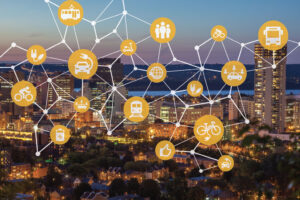By Adamo Donatucci
Like any industry heavily reliant on technology, the urban mobility marketplace continues to evolve with advances in available and emergent technologies. Today, it is common for owners and operators to use technology to engage their customers virtually while retaining an element of personalized interaction.
During the COVID-19 global pandemic, the healthcare industry has proven to be a fascinating case study in the application of advanced parking technology to support the vertical’s broader goals of increasing staff and patient safety while simultaneously reducing hospitals’ and clinics’ capital and operating costs.
Virtualization of the customer experience was driven initially by market preferences for technology-forward service solutions that generated value for parking operators by reducing overall expenses without sacrificing the high level of service that draws traffic to their facility. While this remains an important consideration today, the COVID-19 global pandemic has accelerated efforts to provide the services people need at a distance that keeps them safe.
Early efforts to virtualize the customer experience centered around providing lower-cost alternatives to on-site staffing by directing intercom calls from an attendant’s desk to an off-site monitoring station to save on staffing costs. Today’s technology gives parking operators the flexibility to deploy AI-driven kiosks that assist users to navigate large and complex facilities; in some deployments, this includes turn-by-turn directions back to their car based on the license plate number they enter.
With a greater-than-ever demand for touchless access solutions, parking operators are developing new systems that let users interact with the equipment without ever coming into contact with it; some suppliers have even found ways of integrating gestures to activate ticket dispensing and are leveraging Bluetooth Low Energy technology for permitted access. And just arriving on the market are technology integrations that begin the virtual customer experience before drivers…
By Alicia Smart, Passport
Over the past decade, the City of Hamilton has experienced a tremendous influx in urban growth and development. The City, known for its tourism and medical research, is also the fastest growing mid-sized city in Canada for tech and healthcare. This rapid growth and urbanization have caused the City to reimagine its parking operations.
Many areas in Hamilton are undergoing secondary plans to ensure that there are land use, transportation, and infrastructure plans in place to meet the needs of the growing communities. Hamilton’s parking operation handles all on-street parking related matters, inclusive to parking bylaws. In addition to the day-to-day parking that occurs on Hamilton’s 2,700 on-street and 5,000 off-street paid parking spaces, construction, special events and filming heavily utilize parking. Many of the core parking surface lots have made way for urban growth and Hamilton expects this to be a growing trend over the next 10 years.
Up until 2019, a large portion of the City’s parking operation was simply collecting and reconciling cash and coin. Enforcement operations caused a number of issues at the time, including hardware malfunctions and coin jams. Additionally, data collection was almost non-existent due to the coin and cash dependence. “When I joined the parking system in 2017, what I saw was a large group of very hardworking people who were working too hard at the expense of manual processes,” says Amanda McIlveen, City of Hamilton parking operations and initiatives manager. “From past experience, I knew that Hamilton was in need of a massive digital transformation.”
Amanda and her team quickly realized that in a data-heavy industry, it is difficult to run a parking operation efficiently using antiquated and manual processes. Leveraging data allows cities to manage and allocate staff properly, manage parking demand, create efficiency in…
By Baptiste Corno
Dynamic pricing is clearly the solution nowadays to boost your parking facilities revenue, enhance customer experiences, increase the attractiveness of a city center, lead urban flow and provide drivers with discounted parking spaces. Drivers, parking managers or city managers, this article is made for you.
Our world and our society, are in constant evolution. We will witness considerable changes in the next decade. Some major events have already changed our world this year and we are likely to see more. This decade is the start of a new cycle. We must individually and collectively reconsider our habits and consumptions modes to sustain our future.
Mobility must be one of the top priorities to reconsider. It must evolve toward more autonomy, shared transportation, environmentally friendly and connected usage. Car Parks must also evolve in the same direction and all of us must adopt a very positive approach if we want to succeed.
The development of dynamic pricing solutions in parking facilities is one of the first areas to change because it will help everybody in the community, especially consumers and their budgets. By helping a wider range of the population, Dynamic Pricing can be used as a public policy that benefits a large number of people while providing optimization for private entities. Dynamic Pricing can be the solution of numerous challenges. Xavier Zakoian, CEO & Founder of Kowee, leader in Dynamic Pricing solution for the parking industry stated that: “The objective to achieve is not necessarily revenue optimization. It can be, but it can be customer satisfaction, customer targeting, occupancy maximization and so on”. Dynamic Pricing techniques are an answer to the actual issue regarding urban traffic flow in Smart Cities.
Infotraffic presented an example of Dynamic Pricing strategy at the Virtual Canadian Parking Association Conference…
By Joni Eros
We take choice for granted in our daily lives. We choose what we’ll eat or drink; what we listen to on the radio or watch on tv; what products we use each day; and who to befriend in our lives. There’s a cliché about life being about choices, but it’s true. We make so many every day that we begin to take them for granted.
Historically, choice has not been a significant element of parking. Sure, drivers get to choose where to park, but that is pretty much where their freedom of choice ends. Once they choose a parkade or on-street space, the parker has to use the meter the city has installed, or the PARCS or pay-on-foot equipment the garage offers.
Why does choice matter when it comes to parking payment? Simply put, we don’t all like the same things. Some people are Coke, some are Pepsi; some are Apple, and some are Windows; some like Tim Hortons and some—ok, everyone likes Tim Hortons.
The chasm is particularly wide when it comes to technology. The most obvious 21st Century example can be found in smartphones. Some of us are iPhone users and some are Android. Different people experience technology differently, and that affects their preferences. While one phone may seem alien in its layout and functionality, the other seems entirely intuitive.
The good news is that the evolution of the parking landscape is drastically changing, providing drivers more choice than ever. This is particularly true when it comes to mobile payment. As mobile payment becomes increasingly popular, municipalities, institutions of higher education, and private parking operators are adopting the multi-vendor model on a global scale. And this increased choice benefits both drivers and parking organizations.
Choice Benefits Everyone
In today’s technology-dominated parking world,…
By Kevin Uhlenhaker
More than six months into the Covid-19 pandemic, the parking industry is still reeling. Canada has done better than its neighbor to the South, but the measures that were required slow the spread of the virus (at least relatively speaking) have also had a major impact on parking and transportation. The combination of government-enforced lockdowns and corporate work-from-home policies decimated parking demand, and while people have begun to venture out again and the economy is showing signs of rebounding, public experts tell us to prepare for a very difficult winter.
In fact, the impact of the pandemic will be felt for years to come. Parking revenues at least in many locations will likely be down for the foreseeable future—at least into next spring and, perhaps summer—as public health will be a primary consideration in how owners and operators manage their parkades.
New Approaches to Staffing
One of the most obvious impacts of the Covid-19 crisis on parking operations will be found in staffing. As parking lots and parkades begin to fill up again, parking owners and operators will need to find ways to minimize interactions between staff and parkers. Many experts believe that the Coronavirus is still going to present an on-going risk even after there is a widely distributed vaccine. Without draconian governmental intervention a non-insignificant portion of the population will opt to not get the vaccine and for others, it may not be 100% effective or long lasting.
Parking owners and operators can help to protect their customers and employees by limiting face-to-face interactions. That begins with moving staff out of areas of the facility where they are likely to come into direct contact with parking customers. The most obvious place to start is at exit booths. When staff are taking payment…
By Blake Laufer
Author’s Note: I was fortunate to present at the recent CPA Virtual Conference on the topic of AI, data, and video analytics in parking. As a result of that presentation I was asked to expand on the topic for an article.
According to professor Pedro Domingo at the University of Washington: “People worry that computers will get too smart and take over the world… but the real problem is that computers are too stupid and they’ve already taken over the world.”
Parking managers recognize the need to have data for decision-making. When meeting with colleagues or bosses every decision needs to be supported by charts and graphs and data to garner support. The good old days management by intuition and experience are gone.
Computing systems, and especially those we find in parking operations, are wonderful at collecting massive quantities of raw data. But raw data isn’t useful to the typical parking manager; the data needs to be converted into information before it is useful.
Raw data is a raw material like iron ore, while processed data is like finished metal, something that can be used for productive ends.
Artificial intelligence comes in a variety of forms including natural language processing (“OK Google…”), making recommendations such as what to purchase on Amazon or what to watch on Netflix, and even predictive analytics (hurricane forecasting).
In parking there is one type of AI that we encounter the most, machine learning.
Machine learning is an application of pattern matching. That is, if you show the computer enough patterns then it becomes able to detect and predict that pattern in new data that it has never seen. A simple pattern may only need 10 or 20 inputs before the machine starts to recognize it. A complex pattern…









